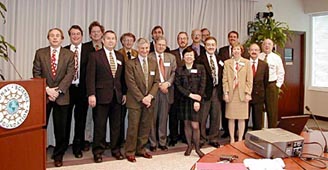
 
Presidential Advisory Committee Report Spurs $366 Million Information Technology Initiative |
||
| Recognizing the critical importance of strengthening the nation's technological leadership and opportunities, President Clinton and Vice President Gore have proposed a $366 million, 28% increase in the government's investment in information technology research. Known as IT2 (Information Technology for the Twenty-First Century), the initiative is largely a result of recommendations made by the President's Information Technology Advisory Committee (PITAC). Established in 1997 by President Clinton, PITAC is co-chaired by CRPC Director Ken Kennedy and Bill Joy of Sun Microsystems. Kennedy and Joy together received the CRA Distinguished Service Award this year for their work on PITAC (see "CRPC Director Ken Kennedy Wins Computer Research Association Distinguished Service Award"). |  PITAC members at their February 1999 meeting held at NSF headquarters in Arlington, VA. Co-chair Ken Kennedy is in the second row, far right. |
|
|
"Information technology presents enormous opportunities for growing the
economy and improving health care, education, public safety, the
environment, and many other areas of importance to the nation," Kennedy
stated at an October 6, 1998 hearing that focused on the PITAC Interim
Report. "To capitalize on these opportunities, we should be increasing
federal investments in this critical area to levels commensurate with its
importance to the nation and to the government. We urge you to take steps
now to ensure that the people of the United States continue to enjoy the
fruits of the information revolution into the next millennium."
The final PITAC Report to the President, released in February 1999, concluded that the government was under-investing in long-term IT research relative to its importance to the nation. The committee, comprised of leaders from industry and academia, concluded that the private sector was unlikely to invest in the long-term, fundamental research needed to sustain the Information Revolution. "This committee strongly recommends that the Federal Government embark upon the kind of leading-edge, visionary research necessary to continue the revolution that has transformed the lives of our citizens in ways not thought possible just 30 years ago," the final report states. "The recommendations of this committee also stress the needs to: 1) upgrade the knowledge base and skills of our workforce so that our citizens will face a new century fully prepared for the technological challenges that are yet to come; and 2) give all Americans the opportunity to participate in the information age, so that our citizens will be able to fulfill its promise. These steps, if taken now, will bring handsome returns to the nation over the coming decades." According to the White House Office of the Vice President, IT2 will support three kinds of activities:
For more information on IT2, see http://www.whitehouse.gov/WH/EOP/OSTP/html/it2.html. To access the PITAC Final Report, see http://www.ccic.gov/ac/report/. |
||
 Other Issues of
PCR Other Issues of
PCR |  Back to PCR Back to PCR |  CRPC Home Page CRPC Home Page |